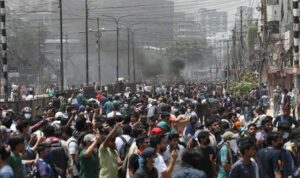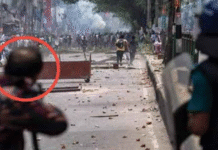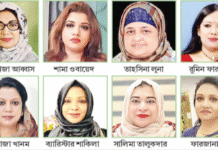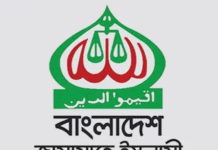
In 2013 covering the Hefazat carnage was easy. We knew the sites of the clashes. It mainly started at Nightingale point at Kakrail and then to Paltan and Motijheel. The next morning when the column of Hefazat supporters headed to Kanchpur, some clashes took place there. So, basically, the dead bodies and the injured were rushed to a few hospitals around those sites. The two Islami Bank Hospitals in Dhaka got a handful of dead. The Dhaka Medical College Hospital had some bodies. The Baraka General Hospital at Rajarbagh got six dead. Then we called hospitals at Siddhirganj, Kanchpur and Narayanganj. By the end of the second day, I remember, we counted 49 bodies. Later when the New York-based Human Rights Watch launched its own investigations, it calculated the death toll at 58.
The killings and mayhem that unfolded last week was so massive that even yesterday we’re getting news that some bodies had ended up in some of the lesser known hospitals. Prothom Alo’s death count is 204. Our total is close to 200. The New Age, which sent four of their reporters to scour some of the hospitals and clinics in the city’s north, has put the death toll to 209. We haven’t got any death figures from the senior government officials, the home ministry or the central police command. I believe they will soon publish their own findings.
The student movement and the mayhem that followed have dwarfed any other violent protests in the country’s history. So, it may take us weeks before we know how many people were actually killed. In previous major protests, all we had to do was to call the police post chiefs at the Dhaka Medical College Hospital. Generally, the officers there are cooperative. They won’t try to hide any death figures. They even describe the circumstances that led to the killings or whether the dead person was shot by live rounds, or hacked or stabbed. They make the job of a crime reporter very easy.
But here in the student protests what we got was that a lot of dead and critically injured ended up in small clinics or hospitals that normally don’t treat the injured from political clashes. The DMCH has so far said more than 80 people died or were brought dead there. But again, what we heard from reporters and eyewitnesses was that some people, when they learnt that the injured they brought to the hospital had already died on the way, didn’t bother to get the death registered at the hospital. If you register a death from unnatural circumstances at the DMCH, the standard procedure is that the hospital will conduct an autopsy of the body in an effort to establish the cause of the death. But many people don’t do it because it entails a lot of hassles and harassment. They have to get a certificate from the police station in whose area the death has occurred.
In Uttara, we’ve got nearly two dozen people dead or brought dead at the Uttara Adhunik Medical College, Kuwait Moitri Hospital and the Uttara Crescent hospitals. We could not count the death number at Kurmitola General Hospital and several other smaller hospitals there. According to the New Age, four people have died in Kurmitola General. In Rampura and Badda, Farazi Hospital, Better Life, Nagorik, AMZ Hospital treated many people. Some were brought dead or died there. But several of the smaller hospitals were left untouched. Many people were treated at the state-run Mugda General Hospital. According to a list the hospital authorities circulated, at least seven people have died or been brought dead there.
A Labaid Hospital official was killed during the violence. The body of the Residential Model College student was taken to a hospital at Mohammadpur. Only on Wednesday, we learnt that 10 people died or were brought dead at the Neuroscience Hospital at Agargaon. And 13 people died or were brought dead at the Suhrawardy Hospital. But we don’t know how many people injured were treated at the cluster of hospitals at Kallyanpur or in Dhanmondi. We haven’t got any casualty statistics from Bangladesh Medical, Ibne Sina, Holy Family, Anwar Khan Modern, Universal (formerly Ayesha Memorial) and Impulse. Since the clashes were all over the city, chances of some dead and critically injured ending up in these hospitals are high.
And Mirpur remained a huge blank spot. In our death toll, we’ve not been able to include any deaths from Mirpur hospitals — if there were any. But we hear reports and anecdotal references that many casualties were brought to the Al Helal and other hospitals. Some of them have died there. Similarly, major clashes occurred at Matuail, Jatrabari, Signboards, Konabari, Shanir Akhra and some of the hugely populated and slum-like lower middle class neighbourhoods in that part of the city. We’ve not been able to touch any of the hospitals there. We could not contact Asgar Ali and Salahuddin Hospital. At the Mitford ( Sir Salimullah) Hospital at least four people had died. But we don’t know whether any casualties were treated at other Old Dhaka hospitals.
Outside Dhaka, major clashes occurred in Rangpur, Narsingdi, Gazipur, Savar, Chittagong and Mymensingh. We’ve got some death figures from these locations. Police said they were busy controlling the law and order situation. Hospitals too didn’t cooperate. A district correspondent said he knew three people had died in one clash, but the relatives did not register their deaths in the hospital registry. It is extremely hard to rely on this anecdotal evidence. Lack of internet access means we could not verify those claims through official sources. Generally police in rural districts reveal the death toll without a hesitation. But this time they might be overwhelmed.
One pitfall of hospital count is these figures could be double counted. One person who died at a hospital might have ended up at Dhaka Medical College Hospital. The chances, however, are low because once the relatives know that their dear one has died, they usually don’t bother to take the body to the DMCH for listing or autopsy. The only way we can know whether a deceased was double counted is through the registries of the hospitals. If one name ended up in death registries of both DMCH and Uttara Crescent, we can easily trace that figure through address and phone numbers. But that is a job of the government.
My understanding is that if we are sincere or if any of our top newspapers and TV stations employ their energy by sending a dozen reporters to scour hospitals in Dhaka and outside, they can easily find out the actual death toll of the events of the past couple of weeks. Obviously it also requires sincerity on the parts of the hospitals. I don’t trust the TV stations as already they have stopped airing any news about the students and people who have died there or hundreds of students and people who were hit on the eyes by rubber bullets. They are spending all their airtime on charred cars, offices and police booths and the damaged Metro rail
#DhakaDiary









